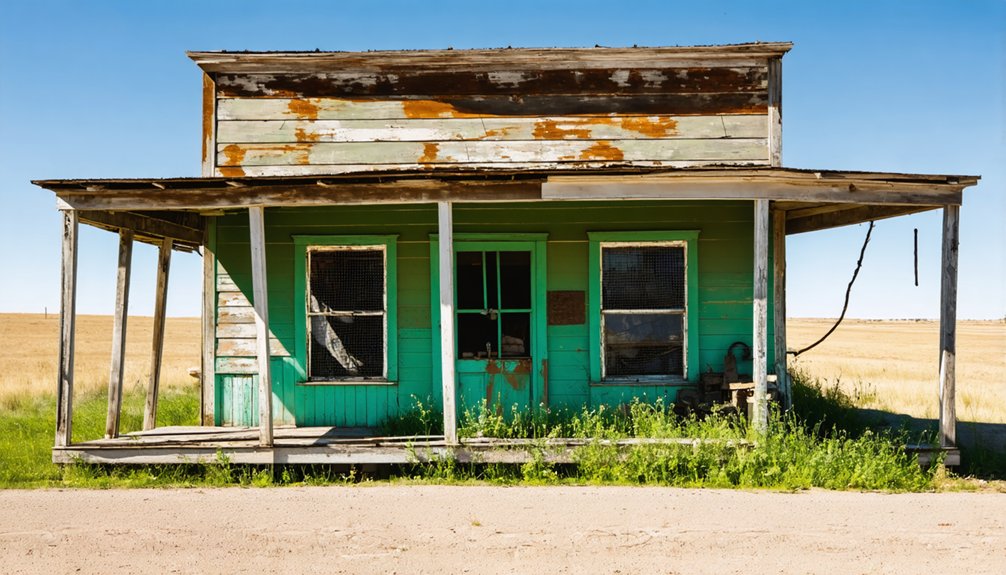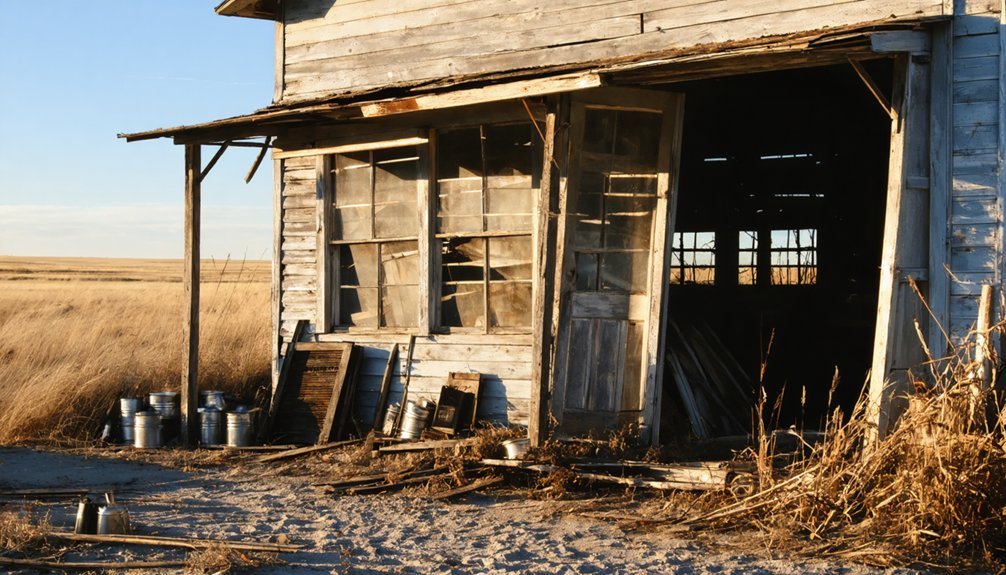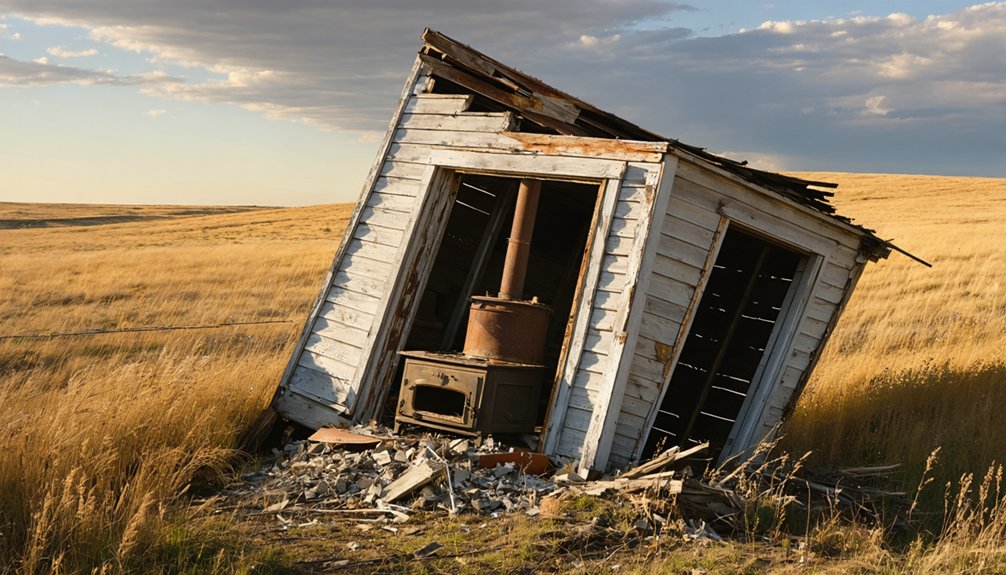You’ll find Poorman’s Gulch, a gold rush settlement from 1874, tucked away in Lawrence County, South Dakota. This once-bustling mining community emerged during the Black Hills gold rush, attracting prospectors who extracted fortunes from nearby Deadwood Gulch. Today, nature has reclaimed the site where miners once used pans, rockers, and sluice boxes to work the placer deposits. While few visible remnants exist, the site’s rich history holds fascinating tales of triumph and tragedy.
Key Takeaways
- Poorman’s Gulch emerged during the 1874 Black Hills gold rush, becoming part of the mining network around the Homestake Mine.
- The site is now a barren ghost town in Lawrence County, with nature having reclaimed most traces of original settlement.
- Miners used simple techniques like pans and sluice boxes to extract gold from shallow placer deposits in the area.
- Notable pioneers William Gay, Alfred Gay, and John B. Pearson helped shape the early development of Poorman’s Gulch.
- Access to the historic site requires landowner permission, with no visible building foundations or prominent ruins remaining today.
The Birth of a Mining Settlement
When gold was discovered in South Dakota’s Black Hills region in 1833, it wasn’t until Horatio Nelson Ross’s 1874 find in French Creek that the area truly sparked to life.
You’d have found prospectors flocking to the gullies and creeks south of Lead, where Poorman’s Gulch emerged as a natural gold trap during heavy rains and snowmelt.
The mining techniques were straightforward – pans, rockers, and sluice boxes ruled the day as prospectors worked the shallow placer deposits. The area’s geology included the Poorman Formation which contained ancient metamorphosed basalt.
During the gold rush, independent miners staked their claims under U.S. mining laws, working in small partnerships rather than large companies.
Small-time prospectors claimed their slice of Black Hills gold, partnering up rather than joining the big mining operations.
While the nearby Homestake Mining Company dominated the region’s hardrock mining, Poorman’s Gulch remained a haven for individual prospectors seeking their fortune in its gold-rich alluvium.
Today, the area encompasses 112 unpatented lode-mining claims covering approximately 1,432 acres of mineral-rich terrain.
Daily Life in the Black Hills Boomtown
Life in Black Hills boomtowns revolved around the chaotic rhythm of mining and commerce, where you’d find a diverse mix of prospectors, merchants, and entertainers crowding the muddy streets.
You’d navigate through a world of cultural diversity and social tensions, where the unwritten miner’s code governed daily interactions more effectively than any formal law.
Your survival meant adapting to primitive conditions – hauling water from creeks, lighting your shanty with oil lamps, and protecting yourself since no police force existed. The typical ratio of nine men to one woman shaped the social dynamics of the community.
You’d gather at saloons and boarding houses to exchange news and settle disputes through miner’s courts.
While theft remained rare due to collective enforcement, you’d still carry a firearm for protection.
Basic services like medical care came at a premium, if you could find them at all. The discovery of gold in French Creek in 1874 had sparked the initial rush of fortune-seekers to the region.
Mining Operations and Gold Discoveries
The discovery of gold transformed the Black Hills into a mining powerhouse, with operations ranging from simple placer mining to sophisticated underground extraction.
You’ll find that early prospectors used basic mining techniques like mercury amalgamation and blowpipe tests to identify precious metals before staking their claims.
The region’s rich gold mineralization became evident when the Homestake Mine struck paydirt in 1876, eventually yielding an astounding 40 million ounces over 126 years.
In 1876, the legendary Homestake Mine revealed the Black Hills’ golden wealth, producing 40 million ounces across 126 years.
The Poorman Anticline area proved particularly promising, with significant deposits found at depths between 2,600 and 4,100 feet.
New extraction methods like chlorination and smelting were introduced by 1890 to process more complex ores.
Companies like Golden Reward Mining expanded rapidly, amassing over 3,400 acres by 1897.
Even smaller operations, like the Cloverleaf mine, produced impressive yields – extracting 43,885 ounces of gold between 1878 and 1937.
The nearby Bald Mountain District generated substantial returns through both underground and surface operations, producing approximately 1.4 million ounces of gold through 1959.
Town Layout and Historic Buildings
Rugged terrain and steep gulches mark this barren ghost town site in Lawrence County, where nature has reclaimed nearly all traces of the original settlement.
You’ll find few remnants of the town layout that once defined this Black Hills mining community near Central City. If you’re keen on exploring, you might spot faint traces of historic foundations where wooden buildings once stood, though they’re increasingly difficult to identify among the natural landscape. The site has largely reverted to pasture, reflecting the common fate of abandoned settlements in the region.
Like many temporary mining camps of the late 1800s, the settlement featured hastily constructed wooden structures, including basic stores and miners’ cabins clustered near the gulch. A careful examination of the area requires patient ghost town hunting to discover what remains of this once-bustling community.
Today, you might encounter scattered rubble piles or ash heaps – subtle clues to the town’s brief but significant role in Black Hills mining history.
Notable Characters and Local Stories
You’ll find that early mining figures William Gay, Alfred Gay, and John B. Pearson, who first staked claims in nearby Deadwood Gulch in 1875, shaped the pioneer spirit of Poorman’s Gulch and surrounding settlements.
Like many who sought their own 160 acres through the Homestead Act, these determined settlers faced harsh weather conditions and started with nothing but dreams of prosperity.
The town’s saloons buzzed with tales of prospectors who’d struck it rich or lost everything, creating a legacy of both triumph and tragedy in the Black Hills mining era.
Many of these early characters moved between booming mining towns like Deadwood or Terry, leaving behind stories of gunfights, rowdy behavior, and wild saloon scenes that became part of regional folklore.
By 1876, the area saw incredible success with gold production reaching $1.5 million in Deadwood Gulch, attracting thousands of hopeful miners to the region.
Legendary Prospectors and Pioneers
Drawn by rumors of gold in the Black Hills, countless prospectors and pioneers made their way to Poorman’s Gulch near Lead, South Dakota, during the late 1870s.
The gold rush fever that swept through the region brought fortune seekers from all corners, each hoping to stake their claim in the mineral-rich gulches and creeks.
- George Hearst and his partners dominated the area through the Homestake Mining Company
- Local prospecting legends tell of both spectacular strikes and devastating losses
- Early pioneers faced harsh weather and challenging geological conditions
- Individual prospectors worked smaller claims throughout Poorman’s Gulch
- The Poorman Formation’s unique geology influenced where miners searched for gold
These bold pioneers left an indelible mark on the Black Hills, though many of their stories have faded into the mists of time.
Saloon Tales and Disputes
While tales of the Old West often blur the line between myth and reality, the stories that emerged from Saloon No. 10 in Deadwood stand firmly in historical record.
You’ll find echoes of infamous saloon disputes that shaped the town’s legacy, from Wild Bill Hickok‘s fatal poker game to the power struggles of Al Swearengen at the nearby Gem Theater.
The original No. 10 burned down in 1879, but the current establishment keeps those stories alive through nightly re-enactments and South Dakota’s largest whiskey collection.
Some say ghostly encounters still occur where Wild Bill and Calamity Jane once roamed.
What began as a Prohibition-era speakeasy has evolved into a family-owned treasure, preserving six decades of frontier spirit amid sawdust floors and historical artifacts.
The Decline and Abandonment
As South Dakota’s mining towns flourished during the gold rush era, few residents could have predicted their eventual abandonment.
You’ll find that economic vulnerabilities and community fragmentation took their toll as mining operations dwindled, forcing families to seek opportunities elsewhere.
- Global market changes made local mining operations less profitable
- Infrastructure maintenance became impossible with shrinking tax bases
- Harsh weather conditions strained already limited resources
- Environmental degradation from mining reduced land sustainability
- Lack of economic diversification left no alternative industries
The town’s decline accelerated as businesses shuttered and social bonds unraveled.
Buildings fell into disrepair, roads crumbled, and nature began reclaiming the land.
What was once a bustling mining community transformed into silent evidence of the boom-and-bust cycle that defined the American frontier.
Preservation Efforts and Current Status

You’ll find no formal preservation efforts at Poorman’s Gulch, as the site lacks both organizational oversight and protected status typical of maintained ghost towns in South Dakota.
The barren location offers no visitor facilities or interpretive displays, and public access remains uncertain due to undocumented land ownership status.
What little remains of the original settlement has deteriorated into minimal foundational traces, presenting significant challenges for future historical documentation or preservation initiatives.
Current Preservation Challenges
Despite its historical significance, Poorman’s Gulch faces mounting preservation challenges that threaten its remaining structures and cultural heritage.
You’ll find limited funding sources and community engagement make it difficult to implement effective preservation strategies, while harsh South Dakota weather continues to deteriorate the site’s historical integrity.
- Dedicated preservation funding is scarce, as grants typically favor more prominent ghost towns like Galena.
- Environmental challenges include severe weather damage, vegetation overgrowth, and soil erosion.
- Local advocacy remains minimal due to the site’s isolation and low public awareness.
- Tourism promotion efforts lag behind other regional ghost towns, reducing potential support.
- Restoration efforts are hindered by high costs and lack of organized volunteer involvement.
The combination of these factors creates an urgent need for innovative solutions to protect this piece of South Dakota’s mining heritage.
Historic Site Access Rules
When visiting Poorman’s Gulch, strict access protocols protect both the site’s fragile historical resources and visitor safety.
You’ll need to secure explicit access permissions from landowners or managing entities before entering, as the site lies on private or restricted land. Unauthorized entry isn’t just discouraged – it’s illegal.
Your visitor conduct must align with preservation guidelines.
Don’t climb on unstable structures, stay on designated paths, and never remove artifacts from the site. You’re responsible for packing out any trash and leaving the environment undisturbed.
Vehicle access is typically restricted, and group sizes may be limited to prevent overcrowding.
During vulnerable seasons, especially winter or wet conditions, additional access limitations might apply to protect the site from erosion and structural damage.
Structural Remains Assessment
Once a bustling mining camp in Lawrence County’s Black Hills, Poorman’s Gulch has deteriorated into what experts classify as a “barren site.”
Today’s visitors won’t find any standing structures or prominent ruins – the former settlement has virtually vanished, with its footprint barely discernible beneath years of natural reclamation.
Recent structural analysis reveals the site’s extreme deterioration compared to other Black Hills ghost towns:
- No visible building foundations remain accessible for site documentation
- Natural vegetation has reclaimed most of the former settlement area
- Unlike nearby Galena or Spokane, no structures survived
- No active preservation efforts are currently underway
- Historical records, not physical remains, confirm the site’s existence
You’ll find the site’s value lies primarily in its historical significance rather than tangible remains, as time and nature have erased most traces of this once-thriving mining community.
Exploring the Ghost Town Today

Today, Poorman’s Gulch stands as one of the Black Hills’ most elusive ghost towns, with virtually no visible structures remaining at the site.
If you’re planning ghost town exploration here, you’ll need GPS coordinates and possibly local guidance to locate this remote destination among Lawrence County’s mining areas.
You won’t find tourist amenities or interpretive signs at this barren site, so come prepared for self-sufficient adventure.
The area’s historical significance lies beneath the natural overgrowth, where scattered foundations and debris tell tales of the Black Hills gold rush era.
While exploring, you’ll need to watch for unstable ground from old mining activity and respect private property boundaries.
For the best experience, consider connecting with local historical societies who can provide context about this vanished mining camp’s past.
Legacy of Poorman’s Gulch
Although Poorman’s Gulch itself has largely faded into obscurity, its legacy remains deeply woven into the broader tapestry of Black Hills mining history.
You’ll find its cultural significance reflected in the region’s transformation from a remote frontier to a thriving mining district. The economic impacts of gold discoveries here contributed to the development of nearby communities like Lead, where wealthy mining entrepreneurs built impressive homes.
- Part of the 1874 gold rush that forever changed the Black Hills
- Connected to the broader mining network centered around the Homestake Mine
- Influenced the region’s cultural dynamics through the influx of diverse settlers
- Contributed to the area’s economic growth and infrastructure development
- Serves as a reminder of the complex social changes that shaped South Dakota’s mining communities
Frequently Asked Questions
Were There Any Major Crimes or Shootouts Recorded in Poorman’s Gulch?
Besides Father Belknap’s 1921 murder, you won’t find records of major crimes or shootouts there. Despite typical mining disputes, law enforcement records show no other significant violent incidents in the area.
What Native American Tribes Lived in the Area Before Mining Began?
Like watchful spirits of the hills, the Lakota Sioux were the primary inhabitants, claiming the land as their sacred territory. You’d also find Cheyenne and Arikara tribes moving through the region.
Did Any Natural Disasters Affect the Town During Its Active Years?
While you’ll find no records of major natural disasters, there could’ve been smaller flooding incidents or mining accidents – but historical documents don’t confirm any significant catastrophes affecting the town’s operation.
What Was the Average Temperature and Climate Like in Poorman’s Gulch?
With temperatures swinging from -20°F to 100°F, you’d experience dramatic seasonal variations year-round. You’ll find average precipitation varies markedly, typical of South Dakota’s Great Plains climate patterns.
Were There Any Documented Epidemics or Health Crises in the Town?
You’ll find limited epidemic history and health statistics for the town itself, though nearby Black Hills communities battled influenza, typhoid, and tuberculosis common to mining settlements in the late 1800s.
References
- https://www.youtube.com/watch?v=Glucs_Rq8Xs
- https://www.sdhspress.com/journal/south-dakota-history-2-3/the-boom-and-bust-of-central-city/vol-02-no-3-the-boom-and-bust-of-central-city.pdf
- https://www.youtube.com/watch?v=_0WNYsFLSLA
- https://www.sdpb.org/rural-life-and-history/2023-08-21/some-black-hills-ghost-towns-and-their-origins
- https://www.southdakotamagazine.com/galenas-ghosts
- https://www.blackhillsbadlands.com/blog/post/old-west-legends-mines-ghost-towns-route-reimagined/
- https://en.wikipedia.org/wiki/List_of_ghost_towns_in_South_Dakota
- https://history.sd.gov/archives/docs/governmentguides/lawrence.pdf
- https://studylib.net/doc/18721930/ruby-poorman-mining-district-ruby-quadrangle–alaska
- https://dakotagoldcorp.com/portfolio/explore-our-gold-properties/poorman-anticline-property/



